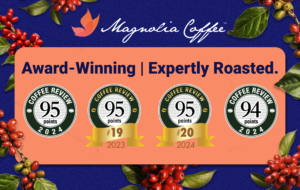Jamaica has long grown coffee, at one time, for a short while, it was one of the world’s largest producers of the crop. Much of the coffee comes from Jamaica’s famed Blue Mountains. Despite its reputation for quality I, like many coffee professionals, cannot remember a time in which it actually was great. I traveled to Jamaica recently to better understand the industry there and why the coffee is perhaps not as good as it should be. On paper it seems the coffee should be great or at least have the potential to be. Mostly of the Typica variety (although I discovered more than that is grown there) and much at high altitude (3500-5000 feet) at a northerly latitude.
I spent my time in Jamaica mostly high in the Blue Mountains at an estate around the 4000 foot altitude. Certainly felt like coffee country there and in an area at the upper limits of possible coffee cultivation. The terrain is quite steep and the view very majestic. Most of the day the coffee was shrouded in clouds; the area receives immense rainfall. In this wet tropical environment grasses and foliage grow incredibly rapidly, growing two feet within a month and needing to be constantly kept in check by machete. The area has experienced several hurricanes in the past decade, severely damaging the coffee fields. I honestly can’t imagine a much more formidable land in which to try and farm coffee.
I expected to see all Typica. (Jamaica has its own strain of Typica called, conveniently enough, Jamaica Blue Mountain which has be planted in many other parts of the world.) While the Jamaica Coffee Board prefers everyone plant Typica, and most of the coffee I saw was Typica, at various times they have recommended planting Caturra, a local dwarf hybrid called 5159 and Geisha. I saw varying amounts of each driving though the coffee country. I expected to see poor harvesting and all mechanical demucilaging and mechanical drying. While it sounds like that may be the case with the bulk of the coffee, I was quite pleased to see artisan production still exists. Excellent picking, traditional fermentation and careful patio and screen sun-drying.
One problem that may be a limiting factor on quality, if not watched carefully, is that coffee is pulped in the mountains and dried down near sea-level in Kingston. If the coffee has not had all of its fruit removed and is quickly transported down to where it will be dried problems can easily arise. Storage in hot port towns like Kingston also can cause coffee to fade prematurely. So while great coffee may be coming out of Jamaica that doesn’t mean it necessarily is making it in that condition to its intended market. This is certainly a concern in many more places than just Jamaica.
How was the coffee I tasted there? When I tasted coffee that was fresh and very well handled it was quite excellent. Not a powerhouse of acidity, not bursting with fruit or flowers, but not a simple coffee either. It was a coffee of great balance, full body, good acidity and wonderful sweetness and with rather interesting hazelnut and savory qualities to the flavor. While much Jamaica Blue Mountain coffee may not be worth the hype, from my experience there, certainly some of it is. If carefully tended to, from harvest to export, I believe a lot more of it could be.











